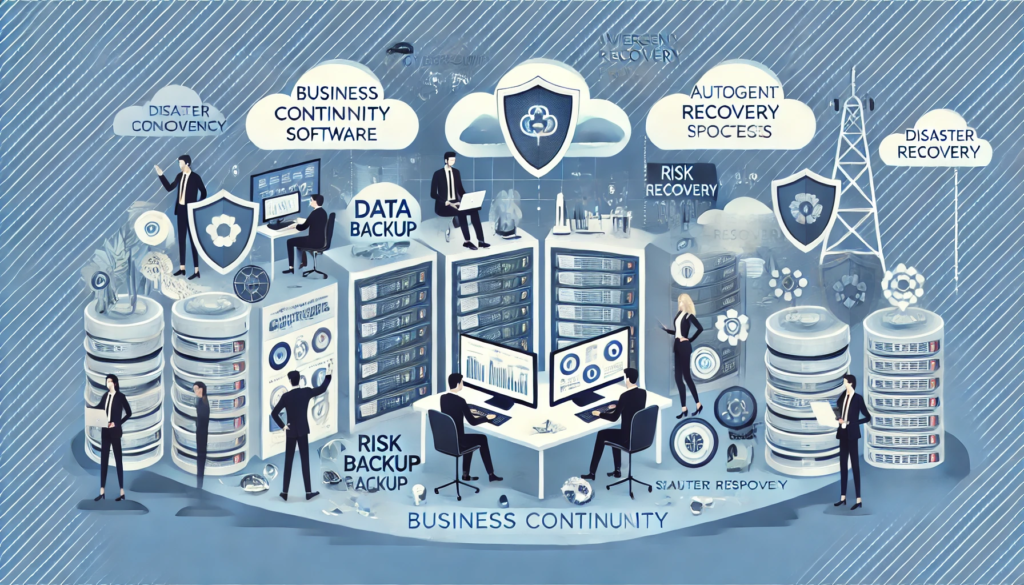Key Takeaways
- Business Continuity Software ensures organizations can maintain operations during disruptions, minimizing downtime and risk.
- Key features include automated disaster recovery, real-time monitoring, and scalability to meet evolving business needs.
- Implementing the right BCS solution helps safeguard data, enhance recovery speed, and ensure regulatory compliance during crises.
In today’s fast-paced, technology-driven business environment, organizations must remain agile and resilient to navigate unforeseen disruptions.
Whether caused by cyberattacks, natural disasters, power outages, or even supply chain disruptions, these unexpected events can severely impact a company’s ability to continue its operations.
The ability to maintain business operations and minimize downtime during such crises is essential for safeguarding both revenue and reputation. This is where Business Continuity Software comes into play.

Business Continuity Software is a specialized tool designed to ensure that a company can recover and continue functioning smoothly during and after a disruption.
By offering real-time monitoring, disaster recovery automation, and failover capabilities, this software provides organizations with the ability to maintain critical services and processes in the face of adversity.
As businesses increasingly depend on technology to drive their operations, the need for an effective and reliable business continuity plan has become non-negotiable.
Understanding what Business Continuity Software is and how it works is crucial for any business aiming to safeguard its operations, data, and workforce.
At its core, this software helps organizations assess risks, prepare for potential disruptions, and rapidly recover from unexpected events to ensure that essential functions continue without significant loss of productivity or financial impact.
Moreover, the evolution of business continuity solutions has made them more accessible, affordable, and versatile than ever.
The integration of cloud-based technologies, artificial intelligence (AI), and automation has streamlined processes and enhanced the effectiveness of Business Continuity Software, making it a pivotal component of any company’s risk management strategy.
From large enterprises to small businesses, adopting business continuity software has proven to be an essential investment to stay competitive and secure in an increasingly volatile market.
This article will explore what Business Continuity Software is, how it functions, and why it’s a vital tool for organizations looking to ensure operational resilience.
We’ll also delve into its core features, benefits, and how to select the right solution for your specific business needs. By the end of this guide, you will have a comprehensive understanding of how Business Continuity Software can help you protect your business from unexpected disruptions and secure long-term success.
Before we venture further into this article, we would like to share who we are and what we do.
About 9cv9
9cv9 is a business tech startup based in Singapore and Asia, with a strong presence all over the world.
With over nine years of startup and business experience, and being highly involved in connecting with thousands of companies and startups, the 9cv9 team has listed some important learning points in this overview of What is Business Continuity Software and How It Works.
If your company needs recruitment and headhunting services to hire top-quality employees, you can use 9cv9 headhunting and recruitment services to hire top talents and candidates. Find out more here, or send over an email to [email protected].
Or just post 1 free job posting here at 9cv9 Hiring Portal in under 10 minutes.
What is Business Continuity Software and How It Works
- What is Business Continuity Software?
- How Does Business Continuity Software Work?
- Key Benefits of Business Continuity Software
- Top Features to Look for in Business Continuity Software
- How to Choose the Right Business Continuity Software for Your Organization
- Challenges and Limitations of Business Continuity Software
- Future Trends in Business Continuity Software
1. What is Business Continuity Software?
Business Continuity Software (BCS) refers to a suite of tools and technologies designed to ensure the continued operation of critical business functions during disruptions, such as natural disasters, cyberattacks, or IT system failures. It provides organizations with the capability to minimize downtime, protect essential data, and quickly recover from adverse events, ensuring that the company’s operations remain stable even in the face of crises.
In today’s increasingly interconnected world, the reliance on technology for business operations is greater than ever. As a result, any disruption in operations, whether planned or unplanned, can have devastating consequences. Business Continuity Software helps organizations prepare for such events by automating recovery processes, providing real-time monitoring, and facilitating the seamless restoration of business activities.
Below, we will break down the key components and functionalities of Business Continuity Software, showcasing its value for businesses of all sizes.
Key Components of Business Continuity Software
- Risk Assessment and Management:
- BCS tools help businesses identify potential risks and vulnerabilities within their infrastructure.
- They allow businesses to prioritize which operations, assets, or services are critical and should be recovered first during a disruption.
- Example: A healthcare organization might prioritize its patient care systems and data over less critical administrative tasks in the event of an IT failure.
- Disaster Recovery Automation:
- BCS automates the recovery process, ensuring that systems, data, and applications are restored quickly and efficiently.
- The software can automatically switch to backup systems or cloud infrastructure to ensure that key operations continue with minimal interruption.
- Example: A financial institution might use BCS to automatically switch to a secure, offsite backup server in case its primary data center experiences an outage.
- Business Continuity Planning (BCP) Integration:
- Business Continuity Software integrates seamlessly with an organization’s existing BCP to ensure that recovery strategies are in place and effective.
- The software aids in aligning business continuity strategies with organizational goals and operational workflows.
- Example: A multinational corporation may rely on a BCS tool that ensures its continuity plan is consistent across all its global branches, minimizing disruption during international crises.
How Business Continuity Software Works
Business Continuity Software operates by utilizing a combination of monitoring tools, data replication, backup systems, and communication protocols to maintain business operations during times of crisis. Here’s how these systems work together to ensure resilience:
- Real-Time Monitoring:
- Business Continuity Software continuously monitors business-critical systems for signs of failure or disruptions.
- It provides real-time alerts and diagnostics, allowing IT teams to respond proactively before an issue escalates.
- Example: In the event of a network outage, the software immediately alerts IT staff, allowing them to initiate backup systems or deploy troubleshooting measures before any significant data loss occurs.
- Cloud-Based Recovery Solutions:
- Most modern Business Continuity Software solutions are cloud-based, enabling rapid failover to cloud infrastructure during an emergency.
- Cloud-based solutions ensure that systems and data are backed up securely, with the ability to scale recovery efforts as needed.
- Example: A tech startup might rely on a cloud-based BCS to restore its website and database within minutes of a system crash, ensuring customer-facing services are unaffected.
- Failover and Backup Systems:
- Automated failover processes ensure that when a system or application fails, it is immediately switched to a backup or replica system with minimal downtime.
- Backup systems replicate essential data at regular intervals, ensuring that the most recent version of critical data is always available for recovery.
- Example: A retail company can utilize a BCS tool that automatically redirects its e-commerce website to a backup server when the primary server fails, allowing customers to continue shopping without disruption.
- Incident Management and Communication:
- Business Continuity Software helps streamline communication during a crisis by providing real-time updates and notifications to key stakeholders.
- It allows businesses to coordinate incident response teams, track progress, and keep customers informed about the status of recovery efforts.
- Example: A telecommunications company might use BCS to notify its customers about service disruptions and provide expected timelines for resolution during a network failure.
Why Is Business Continuity Software Important?
The importance of Business Continuity Software cannot be overstated in a world where downtime can be costly—both financially and in terms of reputation. Here are a few reasons why businesses of all sizes should consider implementing such software:
- Minimizes Downtime:
- Ensures that systems are restored quickly, reducing the duration of operational downtime.
- This minimizes the financial and productivity losses that often accompany periods of disruption.
- Example: An online retailer could prevent losing revenue from lost sales during a server outage by using BCS to quickly restore its online store.
- Protects Critical Data:
- BCS ensures that vital business data is regularly backed up and easily recoverable, protecting against data loss from hardware failures or cyberattacks.
- Example: A law firm can protect sensitive client data with a robust BCS that backs up legal documents and ensures their accessibility even during an IT system crash.
- Maintains Customer Trust:
- Customers expect businesses to provide reliable and uninterrupted services, especially during times of crisis.
- Using Business Continuity Software helps maintain customer trust by ensuring that services continue with minimal disruption.
- Example: A financial institution that uses BCS will maintain access to its banking services, even if its main server is compromised, preserving trust and minimizing the risk of customer churn.
- Compliance with Regulations:
- Many industries require companies to implement specific continuity measures as part of regulatory compliance.
- Business Continuity Software helps organizations meet these legal and regulatory obligations.
- Example: Healthcare providers must comply with regulations like HIPAA, which mandates the protection and availability of patient data during disasters. BCS tools can assist with these compliance requirements.
Real-World Examples of Business Continuity Software
- Veeam Software: Veeam is a popular Business Continuity Software that offers robust data backup and disaster recovery solutions. Used by enterprises globally, Veeam ensures data resilience with features like automated backup, real-time monitoring, and seamless cloud failover.
- Example: A global e-commerce giant could use Veeam’s tools to safeguard its customer databases and ensure a swift recovery in case of a data breach or server failure.
- Zerto: Zerto offers cloud-based disaster recovery and business continuity solutions, designed to ensure that critical IT infrastructure is always available. With advanced data replication and failover features, Zerto is widely used in industries requiring high uptime and reliability.
- Example: A financial services company may use Zerto’s cloud-based BCS solutions to ensure that customer accounts and transaction records remain accessible at all times, even in the event of a server failure.
By understanding the core functionalities and benefits of Business Continuity Software, organizations can make informed decisions about the best solutions to protect their operations, data, and reputation in the event of disruptions. Whether through automated backup, real-time monitoring, or cloud-based recovery, BCS tools provide essential support in ensuring that business processes continue smoothly during challenging circumstances.
2. How Does Business Continuity Software Work?
Business Continuity Software (BCS) is designed to provide organizations with the necessary tools to continue operations during unexpected disruptions, such as natural disasters, cyberattacks, or system failures. This section will explain how BCS works in detail, breaking down its core processes and features that ensure businesses can recover and resume operations quickly and efficiently. By understanding the functionality of BCS, organizations can better appreciate its role in safeguarding their operations and minimizing the impact of potential crises.
1. Real-Time Monitoring and Alerts
- Continuous Monitoring of Critical Systems:
- Business Continuity Software constantly monitors key systems, applications, and data for potential issues or failures.
- It detects any anomalies that could lead to system downtime, such as network issues, server failures, or resource overloads.
- Example: A cloud service provider uses BCS to track server performance. If a critical system starts to fail, the software immediately alerts the IT team to take corrective action before any downtime occurs.
- Instant Alerts and Notifications:
- Once a potential disruption is detected, BCS triggers immediate alerts to relevant stakeholders, such as IT administrators, department heads, and operations managers.
- These alerts can include detailed diagnostics to help resolve issues faster.
- Example: During a system breach, an e-commerce company receives real-time notifications through its BCS tool, prompting the IT team to activate additional security measures and restore affected systems.
2. Automated Disaster Recovery
- Backup Systems and Data Replication:
- One of the core features of Business Continuity Software is automated data backup and replication. Critical business data is continuously backed up to secure locations, ensuring that organizations can recover it quickly in the event of a disaster.
- Data is replicated across multiple servers or cloud environments to ensure redundancy and minimize the risk of data loss.
- Example: A financial services company uses BCS to replicate customer transaction records every few minutes to a remote data center, ensuring that no critical information is lost in the event of a data center failure.
- Failover Mechanisms:
- When a system or application fails, BCS automatically switches operations to backup systems (failover), ensuring that business functions continue without interruption.
- Failover can occur between on-premise systems, off-site backup servers, or cloud platforms depending on the organization’s infrastructure.
- Example: A media company experiences a server crash, but the BCS tool automatically fails over to a backup server hosted on the cloud, ensuring that their digital content remains accessible to users without any downtime.
3. Cloud-Based Recovery Solutions
- Cloud-Hosted Backup and Restoration:
- Cloud-based Business Continuity Software offers significant advantages by hosting backup and recovery operations off-site, reducing the dependency on physical infrastructure.
- This ensures that businesses can recover from data loss or system failure from anywhere in the world, without worrying about hardware limitations or on-premise system vulnerabilities.
- Example: A tech startup uses cloud-based BCS to store all its customer data and application backups on secure cloud servers, allowing the business to quickly recover and resume operations from remote locations in case of a server outage.
- Scalability for Growing Organizations:
- Cloud-based BCS solutions are often more scalable than traditional on-premise solutions, allowing businesses to easily increase their storage and recovery capacity as they grow.
- This scalability makes cloud-based solutions a popular choice for startups, mid-sized businesses, and enterprises that require flexibility in their disaster recovery plans.
- Example: An online retailer experiencing rapid growth can easily scale its cloud-based BCS to accommodate increasing website traffic and database storage requirements during peak seasons like Black Friday.
4. Data Integrity and Security
- Encryption and Security Measures:
- Business Continuity Software ensures that all backed-up and replicated data is encrypted, securing it from unauthorized access, especially during disaster recovery operations.
- Security protocols such as multi-factor authentication (MFA) and role-based access control (RBAC) ensure that only authorized personnel can initiate recovery processes.
- Example: A healthcare provider ensures that patient data remains secure during backup and recovery processes by encrypting all files stored in its BCS system, ensuring compliance with HIPAA regulations.
- Data Consistency Across Systems:
- BCS maintains data consistency by ensuring that data across different systems and backup locations is always synchronized. This guarantees that there are no discrepancies between the active and backup systems, preventing issues during the recovery process.
- Example: A law firm ensures that client files are consistently updated across its live system and backup, ensuring that no information is lost during recovery from an IT failure.
5. Incident Response and Communication
- Streamlined Incident Management:
- BCS provides tools to manage the response to incidents and disasters, from initial detection to resolution. This includes ticketing systems, logs, and recovery workflows to track the progress of the recovery efforts.
- Example: In the event of a power outage, an energy company can use its BCS tool to log each step of the recovery process, from notifying the response team to restarting critical operations and restoring customer services.
- Centralized Communication Hub:
- The software also serves as a centralized hub for communication during disruptions. It allows businesses to send out alerts to employees, customers, and other stakeholders, keeping them informed about the status of recovery efforts.
- Example: During a cyberattack, a retail company uses its BCS system to send notifications to its customers about the service outage, provide updates on the recovery process, and reassure customers that their data is secure.
6. Business Continuity Planning Integration
- Alignment with Business Continuity Plans (BCP):
- Business Continuity Software is closely integrated with an organization’s broader Business Continuity Plan (BCP). This ensures that recovery strategies, such as which systems to restore first or how to allocate resources, are in line with the business’s overall recovery objectives.
- Example: A multinational company uses BCS to ensure that its international operations recover in a phased manner during a disaster, starting with the most critical regions and scaling to other areas based on priority.
- Testing and Simulation Capabilities:
- BCS tools often include features that allow businesses to regularly test and simulate disaster recovery scenarios. This helps organizations ensure their recovery plans are effective and that staff members are trained on how to respond in times of crisis.
- Example: A government agency uses BCS to run simulations of data breaches and network failures to ensure that its IT staff is well-prepared to handle any situation swiftly and effectively.
7. Post-Incident Analysis and Reporting
- Comprehensive Reporting and Analytics:
- After an incident, Business Continuity Software generates detailed reports on the event, including the causes of the disruption, the steps taken during recovery, and the time taken to restore operations.
- These reports provide valuable insights for improving the organization’s business continuity and disaster recovery strategies.
- Example: An insurance company that experiences a system outage uses BCS to analyze how long it took to restore customer services, identifying areas where processes can be optimized to minimize future downtime.
- Continuous Improvement and Updates:
- Based on post-incident analysis, Business Continuity Software can provide recommendations for improvements and adjustments to recovery plans.
- This ensures that the business continuity strategy evolves over time, adapting to new risks and technological changes.
- Example: A logistics company uses post-recovery insights from its BCS tool to enhance its backup strategies, ensuring better preparation for potential supply chain disruptions in the future.
Conclusion
The way Business Continuity Software works is built around ensuring business resilience, recovery speed, and data integrity during disruptions. Through real-time monitoring, automated failover, cloud-based recovery solutions, and integration with incident management systems, BCS tools help organizations minimize the impact of disasters and maintain continuous operations. By incorporating these features, businesses can be better prepared to face crises and ensure that they can recover swiftly, with minimal downtime and data loss. Whether using cloud-based solutions, automated disaster recovery, or real-time communication channels, Business Continuity Software ensures that business operations continue smoothly, regardless of the challenges faced.
3. Key Benefits of Business Continuity Software
Business Continuity Software (BCS) plays a pivotal role in ensuring that organizations remain operational during unexpected disruptions such as natural disasters, cyberattacks, or infrastructure failures. By leveraging BCS, companies can mitigate risks, minimize downtime, and maintain business continuity in the face of adversity. This section will explore the key benefits of Business Continuity Software, providing detailed insights into how these solutions empower businesses to maintain resilience and recover quickly.
1. Minimized Downtime and Faster Recovery
- Quick Recovery from Disruptions:
- Business Continuity Software ensures that businesses can restore critical systems and applications in a fraction of the time compared to manual recovery processes.
- BCS automates recovery workflows, reducing the time needed to restart operations, which is crucial in maintaining customer satisfaction and revenue streams.
- Example: An e-commerce retailer uses BCS to recover its payment gateway within minutes after a server failure, ensuring minimal impact on transactions and customer experience.
- Continuous Operations Through Failover Mechanisms:
- Automated failover processes allow businesses to instantly shift operations to backup systems or cloud environments, ensuring that workflows continue uninterrupted.
- Example: A financial institution activates its failover system during a network outage, allowing employees to work from remote systems and continue serving clients without delay.
2. Data Protection and Integrity
- Real-Time Data Backups and Replication:
- Business Continuity Software continuously backs up critical data to secure, off-site storage locations or cloud environments, ensuring that no vital information is lost during a disaster.
- Replication ensures that backup data is always synchronized and available for restoration at any time.
- Example: A law firm uses BCS to replicate client documents to a secure cloud server, protecting sensitive legal files from potential data loss in the event of a ransomware attack.
- Data Encryption and Security:
- BCS ensures that all data, both in transit and at rest, is encrypted, providing an extra layer of protection against cyberattacks and unauthorized access.
- Example: A healthcare provider uses BCS to encrypt patient records, ensuring HIPAA compliance and protecting sensitive health data from cybercriminals during a system breach.
3. Cost Savings and Resource Efficiency
- Reduced IT Infrastructure Costs:
- By integrating Business Continuity Software with cloud-based solutions, businesses can significantly cut costs related to maintaining physical IT infrastructure, such as backup servers and data centers.
- Cloud-based BCS eliminates the need for extensive on-premise hardware, allowing organizations to only pay for the resources they use.
- Example: A startup reduces IT expenditures by leveraging cloud-based BCS solutions instead of investing in on-premise data storage and backup hardware.
- Optimization of Resource Allocation:
- BCS automates many aspects of disaster recovery, freeing up valuable IT resources that can be allocated to more strategic tasks. With less manual intervention required, staff can focus on innovation and growth rather than constantly managing recovery procedures.
- Example: A manufacturing company implements BCS to automate its backup process, freeing up IT staff to focus on production system enhancements and efficiency improvements.
4. Improved Risk Management and Compliance
- Proactive Risk Identification:
- Business Continuity Software actively monitors key systems for any signs of potential risks, such as network failures, security vulnerabilities, or environmental hazards. This proactive approach helps businesses identify and address risks before they escalate into major disruptions.
- Example: An online retailer uses BCS to monitor traffic spikes, proactively identifying when certain server components are under strain, and reallocating resources before the system fails.
- Regulatory Compliance Support:
- Many industries require businesses to maintain specific levels of data protection and disaster recovery. Business Continuity Software ensures that organizations meet compliance standards such as GDPR, HIPAA, and ISO 27001 by maintaining secure data backups and recovery procedures.
- Example: A financial services firm uses BCS to maintain a compliance-ready disaster recovery plan that ensures they meet industry-specific regulations for data security and recovery time objectives (RTO).
5. Enhanced Business Reputation and Customer Trust
- Maintaining Customer Confidence:
- Business continuity is crucial in maintaining customer trust. By minimizing downtime and ensuring quick recovery, organizations can demonstrate their reliability and commitment to service, even during crises.
- Example: A SaaS company experiences a server crash but is able to restore service quickly with the help of BCS, which assures customers that the service is dependable even during disruptions.
- Ensuring Consistent Service Delivery:
- BCS enables businesses to keep services running without interruption, which is especially critical in sectors that rely on 24/7 operations, such as healthcare, banking, and telecommunications.
- Example: A telecom provider uses BCS to switch services to a backup system during a network outage, ensuring that customers continue to receive uninterrupted service.
6. Increased Operational Resilience
- Business Continuity During Critical Disruptions:
- With Business Continuity Software in place, organizations can operate effectively during natural disasters, cyberattacks, power outages, or other disruptions. By having a solid recovery strategy in place, businesses can weather even the most catastrophic events.
- Example: A shipping company faces a natural disaster that floods its regional headquarters but continues operations by activating its cloud-based BCS solution, ensuring its customers’ shipments are processed from alternate locations.
- Comprehensive Disaster Recovery Plans:
- BCS helps businesses develop, implement, and test comprehensive disaster recovery plans tailored to their specific needs. These plans ensure that all critical business functions can be restored quickly in the event of a disruption.
- Example: A multinational corporation tests its BCS solution bi-annually, simulating a data center failure to ensure its recovery processes are effective and up-to-date.
7. Improved Communication and Coordination
- Centralized Communication Platform:
- Business Continuity Software serves as a centralized hub for communication during and after a disaster, ensuring that all stakeholders (employees, customers, vendors) are informed of the situation and recovery progress.
- Example: A global consulting firm uses BCS to send real-time updates to clients and employees during an office fire, assuring them that client deliverables will remain on schedule despite temporary disruptions.
- Faster Decision-Making and Response Times:
- With clear data and recovery workflows, BCS accelerates decision-making during emergencies, allowing leadership teams to respond quickly and efficiently.
- Example: A manufacturing plant experiences a power failure but is able to make quick decisions about which operations should be restored first, minimizing production delays and keeping client orders on track.
8. Seamless Integration with Existing IT Systems
- Compatibility with Legacy Systems:
- Business Continuity Software is designed to integrate seamlessly with an organization’s existing IT infrastructure, including legacy systems, without requiring major overhauls or disruptions to current operations.
- Example: A hospital integrates its BCS with existing patient record management systems, ensuring that both are automatically backed up and recoverable without requiring manual intervention or additional training.
- Scalability to Meet Organizational Growth:
- As businesses scale, BCS can be easily expanded to support additional systems, data storage, or locations, ensuring that disaster recovery solutions remain aligned with evolving needs.
- Example: A rapidly growing e-commerce company can expand its BCS infrastructure to support increased web traffic and more customer data, ensuring continuous operations even as its needs grow.
Conclusion
Business Continuity Software offers a comprehensive range of benefits, from minimizing downtime and ensuring data integrity to reducing costs and improving operational resilience. By providing tools for real-time monitoring, automated backups, and rapid recovery, BCS enables organizations to maintain uninterrupted operations, safeguard critical assets, and protect their reputation. Whether it’s protecting customer data, ensuring compliance, or minimizing financial losses during disasters, the benefits of implementing Business Continuity Software are undeniable. In today’s fast-paced and unpredictable business environment, having a robust BCS solution is a vital component of any organization’s long-term success and sustainability.
4. Top Features to Look for in Business Continuity Software
When selecting Business Continuity Software (BCS), it’s essential to ensure that it includes key features that will allow your business to recover quickly and efficiently from disruptions. The right software solution should provide comprehensive protection across all business operations, from data storage and backups to disaster recovery and system failover. In this section, we’ll explore the top features to look for in Business Continuity Software, helping you choose a solution that offers maximum resilience, scalability, and efficiency for your organization.
1. Automated Data Backups and Real-Time Replication
- Real-Time Data Replication:
- The best BCS solutions ensure real-time replication of critical data across secure off-site or cloud-based servers. This ensures that the most up-to-date versions of your business data are always available for quick recovery in case of an emergency.
- Example: A financial services firm uses BCS to replicate transaction data across multiple data centers, ensuring that no transaction is lost even if one data center fails.
- Scheduled Backups:
- While real-time replication is essential for continuous data protection, scheduled backups provide an added layer of security by regularly storing data snapshots at set intervals.
- Example: A large retailer schedules daily backups of its inventory management system to safeguard data in the event of system corruption or accidental deletion.
- Granular Backup Options:
- Look for BCS solutions that offer granular backup capabilities, allowing you to back up entire systems or specific files and applications. This flexibility ensures that you can recover exactly what’s needed without unnecessary overhead.
- Example: An online streaming service uses granular backups to preserve video files and customer subscription data separately, enabling quick recovery of both types of data after a server crash.
2. Automated Disaster Recovery Plans
- Pre-Defined Recovery Workflows:
- Business Continuity Software should include automated disaster recovery workflows, which allow the business to activate a recovery process with minimal human intervention. These workflows should be pre-defined based on potential disaster scenarios, including system crashes, power outages, and cyberattacks.
- Example: A manufacturing company automates its disaster recovery plan so that if a production line fails, critical systems are immediately transferred to backup servers, ensuring no delays in operations.
- Customization and Flexibility:
- While pre-defined workflows are helpful, BCS should also allow for customization. The ability to tailor recovery plans to your business’s specific needs and priorities ensures that your organization can recover quickly from any type of disruption.
- Example: A multinational corporation customizes its recovery workflows to prioritize restoring its customer-facing applications, which are essential for maintaining client relations, over less critical internal systems.
3. Cloud Integration and Hybrid Solutions
- Cloud-Based Recovery Options:
- Cloud integration is an essential feature, as it allows for efficient data storage and seamless recovery from any location. Cloud-based Business Continuity Software offers flexibility, scalability, and remote accessibility, which is essential for modern businesses.
- Example: A retail business adopts cloud-based BCS, which ensures that point-of-sale systems can be quickly restored in the event of an in-store server failure.
- Hybrid Cloud Support:
- For businesses with specific data residency or security requirements, hybrid cloud solutions that combine on-premise infrastructure with cloud environments are ideal. This hybrid approach allows organizations to keep sensitive data within private servers while using the cloud for scalability and disaster recovery.
- Example: A healthcare provider uses a hybrid cloud approach, keeping patient records within their local data center for compliance but using the cloud to back up the data and ensure recovery in case of an on-site disaster.
4. Automated Failover and High Availability
- Seamless Failover Capabilities:
- Automatic failover is a critical feature that allows your business to maintain operations without interruption during system outages. When one system fails, BCS should automatically redirect traffic and processes to backup systems to minimize downtime.
- Example: A global e-commerce platform uses BCS to automatically redirect its web traffic to a backup server if the primary server experiences downtime, ensuring continuous availability of its online store.
- High Availability of Critical Systems:
- BCS should offer a high availability setup for mission-critical systems and applications. This ensures that even if one part of the infrastructure fails, there is no impact on the availability of essential services.
- Example: A telecommunications provider uses BCS to ensure high availability for its network operations center, enabling them to continue providing uninterrupted service during network failures.
5. Compliance and Regulatory Support
- Built-in Compliance Features:
- Business Continuity Software should include tools and processes that help ensure your business adheres to relevant industry standards and regulations. For industries like finance, healthcare, and government, BCS solutions that support regulatory compliance are essential.
- Example: A law firm uses BCS to ensure compliance with legal regulations around data protection and disaster recovery, including secure backups that meet GDPR and HIPAA standards.
- Audit Trails and Reporting:
- BCS should provide robust reporting features, allowing businesses to generate audit trails and compliance reports. These reports are necessary for demonstrating adherence to regulatory requirements during audits and inspections.
- Example: A government contractor uses BCS to generate detailed reports of backup processes and system restorations for compliance audits required by federal regulations.
6. Risk Assessment and Proactive Monitoring
- Continuous Risk Monitoring:
- The software should continuously monitor the health of your systems and infrastructure to detect potential risks or vulnerabilities. Real-time risk assessments enable proactive responses before an issue develops into a major disruption.
- Example: A cloud service provider uses BCS to continuously monitor network activity and detect unusual behavior that could indicate a potential security breach, triggering automatic alerts and preventive measures.
- Impact Analysis and Scenario Testing:
- Effective Business Continuity Software includes risk impact analysis and scenario-based testing, which helps organizations assess the potential impact of various disasters and simulate recovery processes.
- Example: A logistics company runs annual disaster recovery simulations to test their BCS solution’s response to supply chain disruptions caused by a natural disaster, ensuring they can respond effectively if the situation arises.
7. User-Friendly Interface and Dashboards
- Centralized Management Console:
- A centralized management console allows administrators to easily oversee and manage disaster recovery efforts across various systems and applications. This central dashboard is crucial for tracking recovery progress and controlling different aspects of the business continuity process.
- Example: An IT manager at a large enterprise uses the centralized dashboard to monitor backup status, recovery progress, and failover procedures across multiple regional offices from one location.
- Intuitive User Interface:
- Business Continuity Software should have an intuitive interface that allows users to easily configure backup schedules, recovery plans, and security measures. The easier it is to use, the more likely it is that employees will adopt the solution and follow proper procedures.
- Example: A small business owner adopts BCS with an intuitive interface that allows them to quickly configure backups, define recovery points, and monitor performance without needing extensive technical expertise.
8. Scalability and Flexibility for Growth
- Adaptable to Business Expansion:
- As businesses grow, their data, IT infrastructure, and recovery needs evolve. Look for BCS solutions that can easily scale to accommodate growth, whether through the addition of new systems, users, or locations.
- Example: A fast-growing SaaS company integrates a scalable BCS solution that can handle increased customer data and higher traffic volumes without compromising recovery time or backup capabilities.
- Support for Multi-Location and Multi-Site Recovery:
- For businesses with multiple locations or remote offices, BCS should offer the ability to manage business continuity across all sites seamlessly. Whether centralized or distributed, the software should provide recovery capabilities for each site as part of a unified strategy.
- Example: A global manufacturing firm uses BCS to manage disaster recovery processes across its plants worldwide, ensuring consistent recovery times and business continuity practices across all locations.
9. Security Features and Data Encryption
- End-to-End Encryption:
- Business Continuity Software should provide robust encryption both in transit and at rest to protect sensitive data during backup, replication, and recovery. This ensures that data cannot be intercepted or tampered with by unauthorized users.
- Example: A financial institution uses BCS to encrypt all backup data during transmission and storage, ensuring that confidential financial information remains secure.
- Granular Access Controls:
- The software should allow administrators to define access levels and permissions for different users within the organization. This helps to safeguard sensitive information and ensures that only authorized personnel can execute critical recovery procedures.
- Example: A law firm restricts access to recovery processes and sensitive client data to senior IT personnel using granular access controls within their BCS solution.
Conclusion
Choosing the right Business Continuity Software is crucial for ensuring that your business can quickly recover from any disruption and maintain operations without significant losses. The features listed above represent the most essential capabilities that any robust BCS solution should include. From automated backups and real-time replication to high availability, risk monitoring, and scalability, these features work together to ensure that your business remains resilient in the face of challenges. When evaluating BCS solutions, make sure that the software not only meets your current needs but is also adaptable to future growth, ensuring long-term protection and peace of mind.
5. How to Choose the Right Business Continuity Software for Your Organization
Selecting the right Business Continuity Software (BCS) is a crucial decision for any organization looking to ensure its operations can withstand unexpected disruptions. The ideal software should not only meet your company’s current needs but also be scalable enough to support future growth. In this section, we’ll explore how to choose the right BCS for your organization, focusing on critical factors such as features, scalability, security, and cost-effectiveness.
1. Understand Your Business Needs and Risks
Before diving into the technical aspects of BCS, it’s essential to have a clear understanding of your organization’s unique needs, operational requirements, and the potential risks it faces.
- Identify Critical Business Functions:
- Determine which aspects of your business are most critical to operations and need to be prioritized during a disaster. This includes identifying key systems, applications, data, and processes that are vital for day-to-day business continuity.
- Example: A healthcare provider identifies patient records and appointment scheduling systems as critical functions that must be protected with immediate failover capabilities in case of system failure.
- Assess Potential Risks and Threats:
- Conduct a risk assessment to understand the types of disruptions your organization is most likely to face. This includes natural disasters, cyberattacks, power outages, hardware failures, and human error.
- Example: A financial services firm assesses the risk of data breaches and cyberattacks as its primary threat, leading it to prioritize high-level security and encryption in its BCS solution.
- Business Size and Complexity:
- Understand how large and complex your organization is. Smaller businesses with a limited number of systems may require a simpler solution, while larger enterprises might need an enterprise-level BCS with more advanced features like multi-site recovery.
- Example: A small e-commerce business may opt for a cloud-based BCS that focuses on automatic data backups, while a multinational corporation might require a more sophisticated solution with global disaster recovery capabilities.
2. Evaluate Key Features and Functionalities
Once you’ve identified your organization’s needs, the next step is to evaluate the features of different BCS solutions to ensure they align with your specific requirements. Key features to focus on include:
- Real-Time Data Replication and Backup:
- Look for software that offers real-time data replication and automatic backups. This ensures that the most up-to-date data is always available in case of a disaster, minimizing downtime and data loss.
- Example: A logistics company opts for BCS with real-time data replication, allowing its inventory management system to recover quickly after an unexpected server crash.
- Automated Disaster Recovery Plans:
- The software should offer pre-defined workflows for disaster recovery that can be easily triggered when necessary. These plans should be customizable and adaptable to different disaster scenarios.
- Example: An online retailer utilizes automated disaster recovery to switch to a backup system immediately in the event of a server failure, ensuring that its website remains operational during peak shopping times.
- Cloud and Hybrid Cloud Integration:
- Cloud-based or hybrid BCS solutions provide greater flexibility, scalability, and remote accessibility. Evaluate whether the software can be seamlessly integrated with your existing cloud infrastructure or whether you require a hybrid setup.
- Example: A growing SaaS company adopts a hybrid BCS solution to back up its customer data across both cloud and on-premise systems, ensuring flexibility and compliance with data residency regulations.
- Failover Capabilities and High Availability:
- Ensure that the software supports automatic failover, which allows the system to switch to a backup server or system in real-time, minimizing downtime during a disruption.
- Example: A telecommunication provider uses BCS with failover capabilities, which automatically reroutes call traffic to another server if the primary server experiences downtime.
3. Scalability and Future Growth
As your business evolves, your continuity needs may change. It’s vital to select a BCS that can scale alongside your growth.
- Scalability for Business Expansion:
- Choose a solution that can easily accommodate future growth, whether it’s an increase in data, systems, or remote locations. The software should be able to expand its backup and disaster recovery capabilities to meet the demands of your growing business.
- Example: A fast-growing fintech company needs a BCS solution that can scale from a small team to thousands of users, enabling seamless disaster recovery processes as it opens new offices globally.
- Cloud-Based Flexibility:
- Cloud-based BCS solutions are often more scalable than on-premise systems, as they offer the flexibility to scale up or down based on usage and demand. Evaluate whether the solution can support your organization’s scaling needs over time.
- Example: A multinational corporation with global offices chooses a cloud-based BCS to ensure that as its operations expand into new regions, the software can scale and support additional infrastructure seamlessly.
4. Security and Compliance
Security is one of the most critical factors when choosing a Business Continuity Software. It’s essential that the software offers robust security features to protect sensitive data, especially if your organization is subject to industry regulations.
- End-to-End Encryption:
- Ensure that the software provides strong encryption both in transit and at rest to safeguard your business’s sensitive data during backups and recovery.
- Example: A healthcare provider selects BCS that encrypts all patient records during transmission and storage to comply with HIPAA regulations and safeguard patient confidentiality.
- Compliance with Industry Standards:
- If your business operates in a regulated industry (such as finance, healthcare, or government), choose a BCS solution that adheres to the necessary compliance requirements, such as GDPR, HIPAA, and SOC 2.
- Example: A law firm opts for BCS that supports data protection laws and regulations in various jurisdictions, ensuring compliance with local laws related to client confidentiality and data security.
- Granular Access Control:
- Look for solutions that allow for role-based access control (RBAC) and granular permission settings, ensuring that only authorized personnel can initiate or modify recovery processes.
- Example: A financial institution ensures that only senior IT staff can access and modify the disaster recovery plan, while junior team members can only view recovery progress.
5. Cost-Effectiveness and Budget Considerations
Business continuity software can vary widely in terms of price, so it’s important to ensure that the solution fits your budget while meeting your needs.
- Evaluate Total Cost of Ownership (TCO):
- Consider the long-term costs of implementing and maintaining the software, including licensing fees, subscription costs, and any additional hardware or services required for integration.
- Example: A startup evaluates the TCO of various BCS solutions, opting for a subscription-based cloud solution that offers affordable pricing as the company grows, with no upfront capital investment required.
- Free Trials and Demos:
- Many BCS providers offer free trials or demos, allowing your team to test out the software before making a commitment. Take advantage of these offers to ensure the software meets your operational needs.
- Example: An e-commerce business tests out a disaster recovery solution with a free demo to assess whether it integrates well with their platform before committing to a full subscription.
- Cost vs. Features:
- While price is a significant factor, don’t sacrifice essential features just to save on cost. Consider the long-term value of the solution and how it supports business continuity during disruptions.
- Example: A large enterprise chooses a slightly more expensive solution due to its advanced automation capabilities, which saves time and reduces manual intervention during recovery processes.
6. Vendor Reputation and Customer Support
Choosing the right vendor is just as important as selecting the right software. A reliable vendor can provide timely support and help your organization recover from disasters efficiently.
- Research Vendor Reputation:
- Look for a vendor with a proven track record in delivering high-quality business continuity solutions. Check customer reviews, case studies, and industry rankings to assess the reliability and reputation of the vendor.
- Example: A government agency selects a BCS vendor with a solid reputation for uptime and reliability, based on reviews and case studies from similar public sector organizations.
- Customer Support and Service-Level Agreements (SLAs):
- Ensure that the vendor offers responsive customer support, with clear SLAs that outline their commitment to recovery times and system uptime during a disaster.
- Example: A law firm with strict recovery time objectives (RTO) signs an SLA with a BCS vendor that guarantees recovery within four hours of a disaster.
7. Integration with Existing IT Infrastructure
For seamless operations, Business Continuity Software must integrate well with your existing IT infrastructure.
- Compatibility with Existing Systems:
- Evaluate whether the BCS solution is compatible with your existing hardware, software, and cloud infrastructure. The software should support a wide range of operating systems, applications, and platforms.
- Example: A tech startup ensures that its chosen BCS solution integrates seamlessly with its existing cloud and on-premise hybrid environment to ensure smooth data backup and recovery processes.
- API and Third-Party Integrations:
- Look for software that offers API support and integrates with other third-party tools, such as monitoring software, security platforms, and incident management systems.
- Example: A retail business integrates its BCS solution with an incident management system to track recovery progress and streamline communications during disaster recovery.
Conclusion
Choosing the right Business Continuity Software is essential for ensuring that your organization can quickly recover from unexpected disruptions and maintain operations without significant losses. By carefully evaluating your business needs, the key features and functionalities of different BCS solutions, their scalability, security, and costs, you can make an informed decision that safeguards your company’s future. Whether you’re a small business or a large enterprise, taking the time to choose the right solution will ensure that your business can withstand disruptions and continue to thrive.
6. Challenges and Limitations of Business Continuity Software
While Business Continuity Software (BCS) is vital for ensuring that organizations can recover quickly from disruptions, it is not without its challenges and limitations. Understanding these potential drawbacks is essential for making informed decisions and ensuring that BCS is implemented effectively. In this section, we will explore the common challenges and limitations organizations may face when using Business Continuity Software, and how these issues can be mitigated.
1. High Initial Costs and Ongoing Maintenance Expenses
Although BCS solutions offer long-term benefits, they often come with high upfront costs and require continuous maintenance, making them less accessible for smaller organizations.
- Initial Investment and Licensing Fees:
- Many enterprise-grade BCS solutions come with hefty upfront costs, including software licenses, implementation fees, and hardware investments for on-premise solutions.
- Example: A mid-sized manufacturing company finds that implementing an on-premise BCS solution involves purchasing new hardware, hiring additional IT staff, and undergoing extensive training, leading to significant upfront investment.
- Ongoing Maintenance and Subscription Fees:
- While cloud-based solutions may have lower initial costs, they often come with recurring subscription fees that can add up over time. These ongoing costs may include updates, system monitoring, and vendor support services.
- Example: A SaaS provider must pay for regular updates, additional storage, and other operational expenses as part of the cloud-based BCS service, which can affect their budget in the long run.
- Cost-Benefit Ratio:
- The overall cost of a BCS solution may not always align with its perceived benefits. Organizations must assess whether the cost of implementation and maintenance justifies the value it provides in the event of a disaster.
- Example: A small retail business might struggle with the high cost of enterprise-level BCS, especially when it faces budget constraints and the likelihood of a disaster occurring is low.
2. Complexity of Setup and Configuration
Implementing Business Continuity Software can be a complex and time-consuming process, requiring careful planning, skilled professionals, and thorough testing.
- Customization and Configuration:
- Most BCS solutions require a high level of customization to align with the specific needs of the organization. Configuring disaster recovery workflows, defining backup schedules, and ensuring data replication across different systems can be a complex task.
- Example: A global financial institution requires highly customized workflows to meet its regulatory compliance needs, which involves extensive configuration of the BCS to adhere to jurisdictional data protection laws.
- Integration with Existing Systems:
- Integration with existing IT infrastructure can pose challenges, especially if the organization uses legacy systems or a mix of on-premise and cloud-based environments. Ensuring compatibility between various platforms and tools can be difficult.
- Example: A large healthcare provider struggles to integrate its BCS solution with outdated patient management software, leading to delays in the deployment process and potential gaps in recovery planning.
- Staff Training and Expertise:
- Employees must be trained to use the BCS effectively, which can be resource-intensive. Without proper training, employees may struggle to activate disaster recovery plans or execute recovery processes correctly.
- Example: A technology startup adopts a new BCS but experiences delays in recovery efforts during a minor disaster because staff members are not sufficiently trained on how to use the software.
3. Data Recovery Limitations
One of the main purposes of Business Continuity Software is to ensure that data can be recovered quickly and effectively during a disaster. However, there are limitations in data recovery processes that organizations should be aware of.
- Data Recovery Speed and Downtime:
- While most BCS solutions promise fast recovery times, the actual speed of recovery can vary significantly depending on the complexity of the system and the size of the data being restored. Larger organizations with vast amounts of data may experience extended downtime during recovery.
- Example: An e-commerce business experiences a delay in restoring its product database and customer data during a server failure, leading to extended downtime and lost revenue.
- Incomplete Data Backups:
- Incomplete or inconsistent data backups can occur due to technical errors or human oversight, resulting in data corruption or loss during the recovery process.
- Example: A law firm discovers that some crucial client data was not backed up due to misconfiguration of the backup schedules, leading to a lengthy process of data recovery and client dissatisfaction.
- Recovery from Remote Locations:
- Organizations with geographically dispersed teams or offices may face challenges when recovering data remotely. Inadequate support for remote access or insufficient bandwidth can hinder the speed and effectiveness of data recovery efforts.
- Example: A multinational corporation faces difficulty restoring critical systems in its Asia-Pacific offices while its North American team manages the recovery from the headquarters, slowing down the overall recovery process.
4. Lack of Real-World Testing and Simulations
Testing is a crucial part of ensuring that a Business Continuity Software solution will work effectively when a disaster strikes. However, many organizations fail to test their systems regularly, which can lead to unpreparedness during real-world incidents.
- Limited Testing Scenarios:
- Many organizations perform limited testing of their BCS, focusing only on specific disaster scenarios rather than running comprehensive tests that cover all potential risks. This can leave gaps in the continuity plans.
- Example: A manufacturing plant performs basic testing of its disaster recovery plan but fails to simulate a scenario involving a cyberattack, leaving it unprepared when such an event occurs.
- Testing Costs and Resource Constraints:
- Full-scale disaster recovery tests can be expensive and resource-intensive, requiring significant IT staff time, system downtime, and involvement from key personnel. Organizations may neglect testing due to budget or time constraints.
- Example: A large enterprise avoids running a full disaster recovery test due to concerns about the impact on normal business operations, resulting in missed opportunities to identify weaknesses in the recovery plan.
- Failure to Update Recovery Plans:
- As business operations and technology evolve, the business continuity plan needs to be updated regularly. Failure to update the plan or re-test it with new technologies can render the plan ineffective during an actual disaster.
- Example: A healthcare organization implements a BCS but fails to update its recovery plan after adopting new medical equipment, resulting in inefficiencies during a recovery operation.
5. Vendor Dependency and Reliability
Most BCS solutions rely on third-party vendors for software support, cloud services, or data storage, which can create dependency and potential risks.
- Risk of Vendor Downtime:
- If a vendor experiences downtime or technical issues, it could affect the performance of the business continuity software. Organizations that rely heavily on vendor-hosted services may face disruptions if the vendor experiences an outage.
- Example: A financial institution that depends on a cloud-based BCS solution experiences delays in recovery when its service provider faces a system-wide outage, resulting in reputational damage.
- Lack of Vendor Support:
- Inadequate customer support or delayed responses from vendors can hinder disaster recovery efforts when time is of the essence. Organizations must ensure that their BCS provider offers reliable and timely support during critical incidents.
- Example: A government agency is unable to reach its BCS provider’s customer support team during a cyberattack, leading to delays in recovering sensitive government data.
- Third-Party Compliance Risks:
- When using third-party services, organizations must ensure that vendors meet necessary security, compliance, and regulatory standards. Failure to do so can expose the organization to compliance violations or data security risks.
- Example: A global retailer fails to verify that its cloud BCS provider complies with regional data protection laws, leading to potential data privacy violations during a disaster recovery.
6. Over-Reliance on Automation
While automation is a key feature of many BCS solutions, relying too heavily on automated recovery processes can lead to mistakes or missed opportunities for human intervention.
- Limited Human Oversight:
- Automation, if not carefully monitored, can lead to situations where the system continues to perform actions that might not be appropriate for the current situation, without human oversight.
- Example: An automated failover process in a retail chain causes the system to switch to a backup server without verifying the integrity of the data, leading to issues with inventory tracking.
- Inflexibility in Unforeseen Situations:
- Automated systems may not always account for every possible scenario, leaving limited flexibility for manual intervention or adjustments in the event of a unique or unexpected disruption.
- Example: A cloud-based disaster recovery system struggles to adapt to a ransomware attack that wasn’t anticipated during automation setup, requiring manual intervention to successfully restore operations.
7. Security Risks and Vulnerabilities
While Business Continuity Software is designed to protect organizations during disasters, it can sometimes introduce security vulnerabilities if not configured properly.
- Insecure Data Storage and Transmission:
- If the software does not implement strong encryption or follow best security practices, sensitive data may be vulnerable to theft or breaches, especially when stored in the cloud or transmitted over networks.
- Example: A healthcare provider’s BCS solution is breached due to insufficient encryption protocols, compromising patient confidentiality and leading to significant regulatory fines.
- Vulnerabilities in Third-Party Integrations:
- Many BCS solutions integrate with third-party systems such as security platforms, data analytics tools, or incident management software. Weaknesses in these integrations can create security gaps and increase the risk of a cyberattack.
- Example: A company’s BCS fails to secure communication with a third-party vendor, allowing a hacker to exploit this connection and access sensitive business data.
Conclusion
While Business Continuity Software is an essential tool for mitigating risks and ensuring that businesses can recover from disruptions, it is not without its challenges. From high costs and complex configurations to data recovery limitations and vendor dependencies, organizations need to be aware of the potential drawbacks and plan accordingly. By addressing these challenges through proper testing, ongoing training, and careful vendor selection, businesses can maximize the effectiveness of their BCS while minimizing the risks associated with its implementation.
7. Future Trends in Business Continuity Software
The landscape of Business Continuity Software (BCS) is constantly evolving to address emerging challenges and incorporate advancements in technology. As businesses face increasingly complex risks—from cyber threats to natural disasters—there is a growing need for more sophisticated, scalable, and adaptable business continuity solutions. In this section, we explore the future trends in Business Continuity Software, focusing on key developments, technological innovations, and evolving best practices that are shaping the industry.
1. AI and Machine Learning Integration
Artificial Intelligence (AI) and Machine Learning (ML) are poised to play a crucial role in the evolution of Business Continuity Software by enhancing predictive analytics, automating responses, and improving the efficiency of recovery processes.
- Predictive Analytics for Risk Management:
- AI-driven algorithms can analyze historical data, identify patterns, and predict potential risks to business operations, enabling proactive preparation for disruptions.
- Example: A financial institution uses AI-powered tools to predict fluctuations in market conditions and proactively adjusts its disaster recovery plans to maintain continuity in the event of an economic downturn.
- Automated Incident Response:
- With AI integration, Business Continuity Software can automatically initiate recovery processes based on predefined scenarios, reducing human intervention and speeding up recovery times.
- Example: An e-commerce platform leverages AI to trigger a series of automated backup and failover actions when detecting an abnormal server crash, minimizing downtime.
- Intelligent Decision-Making:
- Machine learning algorithms can assist businesses in making real-time decisions during a crisis by analyzing incoming data and suggesting the most effective recovery strategies.
- Example: During a cybersecurity breach, a cloud-based BCS powered by AI automatically adjusts recovery protocols based on real-time threat intelligence, ensuring faster recovery while mitigating security risks.
2. Cloud-Based Business Continuity Software
The adoption of cloud-based solutions continues to rise, offering businesses greater flexibility, scalability, and cost-efficiency. As cloud technology evolves, Business Continuity Software is increasingly being delivered as a service (SaaS), allowing organizations to access advanced features without heavy infrastructure investments.
- Scalability and Flexibility:
- Cloud-based BCS enables businesses to scale their disaster recovery plans in response to growth or changing requirements, ensuring that continuity measures remain effective as the organization expands.
- Example: A global retailer expands its operations across multiple regions and utilizes a cloud-based BCS that adjusts to the varying needs of each location without the need for significant infrastructure upgrades.
- Remote Access and Collaboration:
- Cloud solutions provide remote access to business continuity tools, allowing employees to execute recovery plans and coordinate efforts from anywhere, facilitating collaboration during crisis situations.
- Example: During a natural disaster, employees of a multinational company located in different regions can access the cloud-based BCS to execute business recovery processes remotely, minimizing operational disruptions.
- Disaster Recovery as a Service (DRaaS):
- DRaaS is a growing trend where businesses outsource their disaster recovery needs to cloud providers, who ensure that critical data and systems are backed up and ready for restoration in case of failure.
- Example: A startup relies on DRaaS to ensure that all its customer data is backed up securely in the cloud and can be quickly restored in the event of a data breach or system failure.
3. Enhanced Cybersecurity Features
As cyber threats continue to rise in sophistication, Business Continuity Software is integrating enhanced cybersecurity features to safeguard against cyberattacks and ensure that recovery plans can be executed without compromising sensitive data.
- Advanced Threat Detection and Response:
- BCS solutions are increasingly incorporating advanced cybersecurity features, such as real-time threat detection and automated incident response, to help organizations recover quickly from cyberattacks.
- Example: A healthcare provider integrates a BCS that includes advanced intrusion detection systems to identify and respond to ransomware attacks, ensuring that patient data is protected and recovery can be initiated without delay.
- Zero Trust Architecture:
- Zero Trust security models are being adopted by BCS solutions to ensure that no user or device is trusted by default, improving overall security and minimizing the risk of data breaches during a disaster.
- Example: A financial services firm implements Zero Trust security in its BCS, ensuring that each recovery step is validated and secure, and that only authorized personnel can access sensitive recovery data.
- End-to-End Encryption:
- End-to-end encryption for both data in transit and at rest ensures that business continuity processes remain secure, even if recovery systems are accessed by unauthorized parties during a crisis.
- Example: A law firm uses end-to-end encryption in its BCS solution to protect confidential client data, ensuring that even in the event of a system failure or breach, sensitive information remains secure.
4. Automation and Orchestration of Disaster Recovery Plans
The future of BCS will see further advancements in the automation and orchestration of disaster recovery plans, allowing businesses to recover more efficiently with minimal human intervention.
- Automated Failover Systems:
- Automated failover mechanisms will become more sophisticated, automatically switching to backup systems or cloud environments when an issue is detected in primary systems, ensuring business continuity with minimal downtime.
- Example: An online retailer’s BCS automatically shifts its website traffic to a cloud-based backup server in the event of an on-premise system failure, ensuring that customers experience little to no downtime.
- Orchestrated Recovery Workflows:
- BCS platforms will increasingly incorporate recovery workflows that are orchestrated to ensure a seamless and coordinated response during a disaster, allowing for quicker and more efficient restoration of critical systems.
- Example: A telecommunications company uses orchestrated recovery workflows that automatically synchronize system restoration across its network infrastructure, minimizing the impact of downtime.
- AI-Powered Automation in Crisis Management:
- AI-driven automation will enable businesses to activate predefined recovery protocols in response to specific types of disruptions without requiring manual oversight, improving the speed and accuracy of recovery.
- Example: A government agency adopts AI-powered disaster recovery software that automatically adjusts recovery actions based on the type of crisis, whether it’s a cyberattack, natural disaster, or infrastructure failure.
5. Integration with Internet of Things (IoT) Devices
As the Internet of Things (IoT) continues to expand, Business Continuity Software will increasingly integrate with IoT devices to provide real-time data and enhance recovery efforts during a crisis.
- Real-Time Monitoring and Alerts:
- IoT integration will allow BCS solutions to monitor critical infrastructure and provide real-time alerts for potential disruptions, helping organizations respond faster and more effectively.
- Example: A manufacturing plant uses IoT sensors connected to its BCS to monitor equipment health. If a machine fails, the system sends an immediate alert and triggers recovery measures, minimizing downtime.
- IoT-Enabled Backup Solutions:
- IoT devices will play a crucial role in ensuring data is backed up in real time, allowing BCS systems to restore data quickly from distributed devices when required.
- Example: A smart building uses IoT devices to track power consumption and environmental conditions. If a disaster occurs, the system uses this data to optimize the recovery process and restore operations efficiently.
- Enhanced Disaster Recovery with IoT Analytics:
- IoT devices generate vast amounts of data that can be analyzed to gain insights into the causes of disruptions, enabling businesses to fine-tune their continuity plans and prevent similar incidents in the future.
- Example: An energy company integrates IoT analytics with its BCS to analyze power grid data during recovery efforts, improving the speed and accuracy of system restoration.
6. Data Privacy and Compliance Regulations
With increasing global concerns over data privacy and regulatory compliance, Business Continuity Software is evolving to ensure that disaster recovery plans meet the stringent requirements of various legal and regulatory frameworks.
- GDPR and Data Sovereignty Compliance:
- BCS solutions will incorporate features designed to help businesses comply with regulations like the General Data Protection Regulation (GDPR), ensuring that customer data is protected during recovery and that recovery processes align with data sovereignty laws.
- Example: A multinational corporation ensures that its BCS platform meets GDPR requirements by encrypting personal data and ensuring it is only stored in specific regions to avoid cross-border data breaches.
- Automated Compliance Reporting:
- Future BCS solutions will provide automated compliance reporting tools, making it easier for businesses to demonstrate that their disaster recovery processes meet legal requirements.
- Example: A financial institution uses automated compliance reporting in its BCS to generate reports showing that its disaster recovery procedures are aligned with the Sarbanes-Oxley Act, ensuring regulatory compliance.
- Data Integrity and Audit Trails:
- BCS platforms will provide detailed audit trails and data integrity checks to ensure that any recovery actions taken are properly documented and transparent, reducing the risk of compliance violations.
- Example: A healthcare organization ensures that all recovery activities are documented and stored in the BCS to provide a complete audit trail for HIPAA compliance.
7. User-Friendly Interfaces and Customization
Business Continuity Software will continue to evolve with more intuitive user interfaces, making it easier for non-technical users to manage recovery processes. Additionally, BCS solutions will become more customizable to meet the unique needs of different industries.
- Intuitive Dashboards and Visualizations:
- Future BCS platforms will offer more user-friendly dashboards, visualizations, and reporting tools that allow administrators to monitor the status of recovery efforts in real time and make data-driven decisions quickly.
- Example: A global retailer utilizes a cloud-based BCS with a real-time dashboard that visualizes the recovery process and displays key metrics, making it easier for the management team to monitor recovery efforts during a crisis.
- Industry-Specific Customization:
- BCS solutions will become more customizable to address the specific needs and regulatory requirements of various industries, including healthcare, finance, manufacturing, and government.
- Example: A healthcare provider adopts a BCS that is customized to meet the needs of the healthcare industry, ensuring that recovery plans align with HIPAA regulations and patient care requirements.
Conclusion
The future of Business Continuity Software is shaped by technological advancements, growing cybersecurity concerns, and an increased focus on automation and cloud-based solutions. As businesses face new and emerging risks, these trends will help organizations create more resilient, efficient, and adaptable continuity plans. By embracing these innovations, businesses can ensure that they are prepared for whatever disruptions may come, safeguarding their operations and protecting their long-term success.
Conclusion
In today’s volatile business environment, where disruptions can come in the form of natural disasters, cyber threats, or unexpected operational failures, Business Continuity Software (BCS) has become an essential tool for organizations across industries. As companies increasingly rely on technology for their daily operations, ensuring business continuity through advanced, reliable, and automated recovery systems has never been more critical.
Business Continuity Software enables businesses to prepare, respond, and recover effectively from disruptions, ensuring minimal downtime, protecting vital assets, and safeguarding business operations. This software provides an integrated approach to risk management, offering features that help businesses assess risks, create contingency plans, and execute disaster recovery strategies seamlessly. By automating key processes and providing real-time insights, BCS helps reduce human error, optimize recovery time, and maintain operational efficiency during crises.
The Importance of Business Continuity Software
The importance of Business Continuity Software lies in its ability to support businesses in mitigating the risks of unforeseen events, whether they are cyberattacks, power outages, or natural disasters. With the growing reliance on cloud computing, AI, and interconnected systems, business continuity has become more complex. However, the benefits of implementing effective BCS solutions far outweigh the challenges. Some key benefits include:
- Minimized Downtime: BCS ensures that businesses can continue operations without major disruptions, preventing revenue loss, reputational damage, and customer dissatisfaction.
- Risk Mitigation: By providing proactive risk management and automatic responses to disruptions, BCS helps businesses reduce vulnerabilities and ensure they are prepared for a variety of incidents.
- Cost Efficiency: Automating disaster recovery processes and minimizing downtime significantly reduces the costs associated with business interruptions, including lost productivity and emergency recovery efforts.
Moreover, Business Continuity Software also offers features that make recovery processes faster, smarter, and more adaptable, with integrations of cloud computing, AI, and machine learning playing an increasingly important role. These technological advancements allow businesses to implement more agile, scalable, and effective continuity solutions that can evolve with their changing needs.
Key Features and Considerations
When choosing Business Continuity Software, businesses must focus on several critical features, including:
- Automated Disaster Recovery Plans: Automation allows for faster recovery with less manual intervention, significantly reducing the time it takes to restore normal operations.
- Real-Time Monitoring and Alerts: These features help businesses stay updated on potential disruptions and address issues before they escalate.
- Scalability and Flexibility: As organizations grow and diversify, their BCS must be scalable to accommodate changes in size, infrastructure, and operational complexity.
- Data Security and Compliance: Protecting sensitive business data and ensuring compliance with industry-specific regulations is a key aspect of any continuity strategy.
By integrating these features, businesses ensure that they are well-equipped to handle any situation, whether it’s a data breach, a natural disaster, or an IT failure, all while maintaining regulatory compliance and safeguarding customer trust.
The Future of Business Continuity Software
Looking ahead, Business Continuity Software will continue to evolve with advancements in artificial intelligence, machine learning, and cloud technologies. Future trends indicate that the integration of more automated processes, enhanced cybersecurity features, and even greater customization for different industries will continue to shape the future of BCS solutions. Furthermore, as businesses increasingly adopt IoT devices and remote work models, BCS solutions will need to be more adaptable and capable of addressing new risks related to distributed workforces and connected devices.
For example, the rise of remote work and hybrid work environments will require businesses to implement solutions that are accessible and effective across different locations and devices. Similarly, the integration of AI-driven risk assessment tools will enable businesses to identify potential threats more proactively and respond to them in real time. This shift towards AI and automation will revolutionize the way businesses approach continuity, allowing for quicker recovery times, smarter decisions, and more resilient business models.
Final Thoughts
In conclusion, Business Continuity Software is no longer a luxury but a necessity for organizations that wish to safeguard their operations, protect their assets, and ensure seamless recovery during crises. As businesses continue to navigate increasingly complex operational landscapes, the role of BCS in maintaining business resilience will only grow. By adopting robust, scalable, and intelligent Business Continuity Software, organizations can future-proof their operations and ensure that they are well-equipped to respond to both expected and unexpected disruptions.
Implementing the right BCS solution will not only provide peace of mind in the face of uncertainty but will also position businesses to thrive despite adversity, maintaining business continuity and delivering exceptional service to customers, no matter the circumstances.
If you find this article useful, why not share it with your hiring manager and C-level suite friends and also leave a nice comment below?
We, at the 9cv9 Research Team, strive to bring the latest and most meaningful data, guides, and statistics to your doorstep.
To get access to top-quality guides, click over to 9cv9 Blog.
People Also Ask
What is Business Continuity Software?
Business Continuity Software is a tool that helps organizations prepare for, respond to, and recover from disruptions. It ensures that critical operations continue during unforeseen events like natural disasters, cyberattacks, or power outages.
How does Business Continuity Software work?
Business Continuity Software automates recovery processes, integrates risk management, and ensures quick restoration of business operations. It supports planning, monitoring, and real-time response to minimize downtime and protect vital data during disruptions.
Why is Business Continuity Software important?
It is vital for minimizing downtime, protecting critical business functions, and ensuring that companies remain operational in the face of unexpected events. It helps safeguard reputation, revenue, and data integrity during a crisis.
What are the key features of Business Continuity Software?
Key features include disaster recovery automation, real-time monitoring, risk assessment, cloud backups, secure data storage, and incident management. These features help businesses ensure operational resilience during disruptions.
What is the difference between Business Continuity Software and disaster recovery software?
While both aim to ensure business operations during disruptions, Business Continuity Software is broader, covering risk management, planning, and recovery. Disaster recovery focuses specifically on restoring IT systems and data after an event.
How do I choose the right Business Continuity Software for my organization?
Consider scalability, ease of use, automated recovery processes, cloud integration, security features, and compliance with industry regulations. Align the software’s capabilities with your business needs and disaster recovery objectives.
Can Business Continuity Software be used for small businesses?
Yes, Business Continuity Software is scalable and can be tailored to meet the needs of small businesses. It helps ensure that smaller companies can also maintain operations and safeguard data during unforeseen disruptions.
What are the benefits of Business Continuity Software?
Benefits include minimizing downtime, protecting data, ensuring compliance, improving risk management, and maintaining customer trust. It helps businesses recover quickly and efficiently during crises, reducing financial losses.
How much does Business Continuity Software cost?
The cost of Business Continuity Software varies depending on the size of the organization, features, and service level required. Pricing models typically include subscriptions, with some vendors offering customized solutions based on business needs.
Is Business Continuity Software the same as Business Continuity Planning (BCP)?
No, Business Continuity Planning (BCP) refers to the process of preparing for business disruptions, while Business Continuity Software is a tool that supports the implementation of a business continuity plan by automating processes and providing real-time monitoring.
Can Business Continuity Software be used to prevent cyberattacks?
While Business Continuity Software does not prevent cyberattacks, it can help organizations respond quickly and recover from them. It provides data backups, incident management, and risk assessment to minimize the impact of cyberattacks on business operations.
What are some examples of Business Continuity Software?
Examples include Veeam, Datto, Zerto, and Acronis. These software solutions offer various features such as disaster recovery, cloud backups, and automated recovery to ensure business continuity during disruptions.
How does Business Continuity Software protect data?
Business Continuity Software protects data by providing secure cloud backups, encrypted storage, and automated recovery processes. It ensures that critical business data is preserved and can be quickly restored during or after a disruption.
Can Business Continuity Software help with regulatory compliance?
Yes, many Business Continuity Software solutions are designed to help businesses comply with industry regulations by providing secure data storage, automated backup processes, and reporting tools that meet compliance standards.
Is Business Continuity Software suitable for remote work environments?
Yes, many Business Continuity Software solutions are designed to support remote work by providing cloud-based backups, remote access to data, and collaboration tools to ensure business operations continue seamlessly, no matter where employees are located.
How does Business Continuity Software improve disaster recovery?
By automating recovery processes, Business Continuity Software reduces recovery time, ensures faster access to backup data, and minimizes human error during disaster recovery. It helps businesses recover quickly, ensuring minimal disruption.
What industries benefit most from Business Continuity Software?
Industries like healthcare, finance, retail, manufacturing, and government benefit significantly from Business Continuity Software. These sectors rely on data integrity, minimal downtime, and operational continuity during disruptions.
What is the role of cloud computing in Business Continuity Software?
Cloud computing plays a key role by offering scalable data storage, easy access to backups, and faster recovery processes. It allows businesses to store their data securely offsite, ensuring accessibility and security during disruptions.
How do I integrate Business Continuity Software into my organization?
Integration involves aligning the software with existing IT systems, conducting risk assessments, defining recovery objectives, and training employees. Ensure that the software complements your disaster recovery and risk management strategies.
Can Business Continuity Software be used for IT infrastructure management?
Yes, Business Continuity Software often includes tools for managing IT infrastructure by ensuring the availability and integrity of critical systems and networks. It helps prevent downtime and supports quick recovery of IT resources.
What is the difference between business continuity and crisis management?
Business continuity focuses on ensuring that critical operations continue during disruptions, while crisis management addresses the strategic response to a specific emergency. Business Continuity Software supports both aspects by automating recovery and response plans.
How can Business Continuity Software support data recovery during a crisis?
Business Continuity Software ensures that data is backed up regularly and stored securely in the cloud. In the event of a crisis, the software allows for quick restoration of business-critical data to ensure minimal downtime and business disruption.
Can Business Continuity Software help with risk assessment?
Yes, many Business Continuity Software solutions include risk assessment tools that help businesses identify potential vulnerabilities. These tools analyze risks and recommend recovery strategies, improving the organization’s preparedness for disruptions.
What is automated disaster recovery in Business Continuity Software?
Automated disaster recovery allows for the immediate restoration of business systems, applications, and data after a disruption. This feature ensures that recovery processes are faster, more accurate, and less reliant on manual intervention.
How does Business Continuity Software handle system updates during an emergency?
Business Continuity Software manages system updates by ensuring that they do not disrupt business operations. It schedules updates during low-traffic hours and can automate patching to reduce the risk of cyber threats during a disaster.
Can Business Continuity Software reduce operational costs?
Yes, by automating disaster recovery and reducing downtime, Business Continuity Software can help businesses minimize the financial impact of disruptions. It reduces the need for manual recovery efforts, which can be costly and time-consuming.
How do Business Continuity Software solutions ensure uptime?
Business Continuity Software ensures uptime by providing real-time monitoring, automated failover processes, and redundant systems. These features help businesses continue operations with minimal interruptions, even during major disruptions.
How does Business Continuity Software benefit customer service?
By ensuring that operations remain uninterrupted, Business Continuity Software helps businesses continue serving customers without delays. It also enables quick recovery of customer-facing systems, ensuring consistent service during crises.
What is the best way to test Business Continuity Software?
Testing should involve regular drills and simulations to ensure that recovery plans work effectively. Businesses should also conduct a review of the software’s performance during real disruptions and assess its integration with existing systems.
How do I ensure my Business Continuity Software is up to date?
Regular software updates, monitoring of industry best practices, and adapting to changing business needs ensure that your Business Continuity Software stays relevant. Many providers offer automatic updates and patches to keep the software current.
Can Business Continuity Software help with employee communication during a crisis?
Yes, many solutions include communication tools that help businesses stay connected with employees during a crisis. These tools facilitate updates, alerts, and coordination to ensure that all staff members are informed and involved in recovery efforts.
Is Business Continuity Software effective for international operations?
Yes, Business Continuity Software is scalable and can be customized to support international operations. It helps businesses with global reach ensure that their operations remain functional across multiple locations, regardless of disruptions.
What are the common challenges when implementing Business Continuity Software?
Challenges include integration with existing systems, staff training, ensuring data security, and ongoing maintenance. However, these can be mitigated by choosing the right solution, providing adequate training, and establishing a comprehensive recovery plan.
What should be included in a Business Continuity Plan (BCP)?
A BCP should include risk assessments, recovery objectives, communication strategies, and a clear action plan for responding to and recovering from disruptions. It should be regularly updated to reflect changes in the business environment.
How does Business Continuity Software improve business resilience?
By providing robust risk management tools, automated disaster recovery, and real-time monitoring, Business Continuity Software helps organizations adapt to disruptions quickly and maintain critical operations, ensuring overall business resilience.































![Writing A Good CV [6 Tips To Improve Your CV] 6 Tips To Improve Your CV](https://blog.9cv9.com/wp-content/uploads/2020/06/2020-06-02-2-100x70.png)


